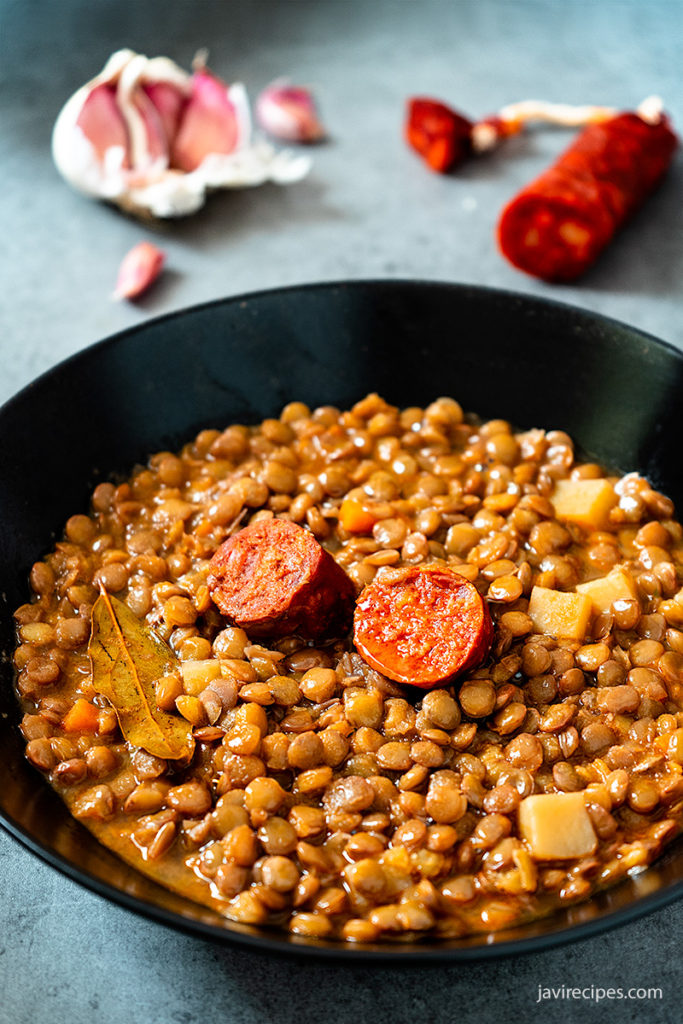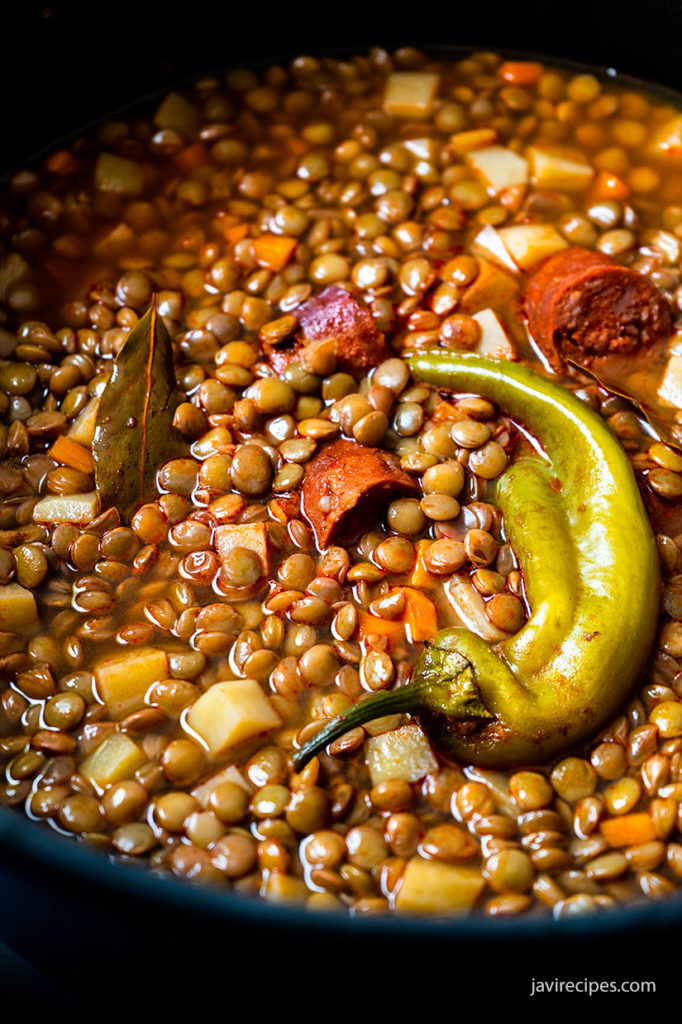- You are here:
- All Recipes / LENTEJAS CON CHORIZO – SPANISH RECIPE
LENTEJAS CON CHORIZO – SPANISH RECIPE
October 25, 2018 BY JAVI RECIPES
Lentejas con Chorizo, in English “Lentils with Chorizo”, is one of the most popular dishes in the Spanish kitchen as it’s very easy to make and is so delicious!
Below you can find the traditional recipe, the way my mother has always prepared it, but before making this lentil soup at home I advise you to read the tips that I have left at the end of the recipe so that they turn out perfect.
HOW TO MAKE SPANISH LENTIL SOUP WITH CHORIZO
INGREDIENTS:
- 2 cups of lentils (400 grams)
- 1 piece of chorizo (approx. 100 grams)
- 1 tomato
- 1 green pepper
- 1 carrot
- 1 medium potato
- 1 onion
- 2 cloves garlic
- 1 bay leaf
- 1 teaspoon paprika (in Spanish “pimentón”)
- 5 tablespoons olive oil
- Salt
INSTRUCTIONS:
- Put the lentils in a colander and rinse them well. Then place the lentils in a pan and add the water.
- Remove the tip from the end of the pepper and place it in the pan. Add the tomato, bay leaf, 1 teaspoon of salt and the teaspoon of paprika.
- Cut the potato into small pieces and add to the lentils in the pan. Cut the carrot into small dices and add. Cut the chorizo into slices and also place in the pan.
- While the lentils are cooking we can prepare the sauté. Chop the onion and cut the garlic into slices.
- Heat a frying pan with the oil and add the onion and garlic. Leave on medium heat until they poach and turn golden.
- Put the sauté into a blender and add half a glass of water. Blend for one minute and then add to the pan and mix.
- Once the lentils are tender (from 45 minutes to 1 hour and a quarter) remove the pepper, tomato and bay leaf.
- Finally, taste the soup to see if it needs more salt and if necessary add a pinch more and that’s it. Don´t forget to add a slice of bread to accompany the “lentejas”!
NOTES:
- This recipe serves 4 people. If you want it to serve 2 then all you have to do is divide everything in half.
- If you want your lentils to have a more intense flavour then you can add a piece of black pudding as well as the chorizo.
- With the vegetables that we cooked (onion, tomato and carrot) you can prepare a thick vegetable soup, a vegetable cream. Keep reading to find out more.
In most Spanish homes this dish is prepared by adding all the ingredients directly to the pan without preparing “el sofrito” (in English “the sauté”) that you have seen in the recipe.
When in Spain a stew is prepared in this way, it´s said that it´s prepared “en crudo”, which in English would be something like “raw”.
The advantage of making lentils this way is that it´s very quick to prepare but it also has the disadvantage that you don´t get the same flavour as when preparing the lentils with a good sauté.
Therefore, the best trick to make delicious lentils is to always prepare a sauté with onion and garlic.
Since I published my lentils recipe in Spanish, 10 years ago, I´ve received many emails from people who have prepared this recipe at home and thank me because they have eaten the best lentil soups of their lives … and all thanks to the flavour that you can achieve from a simple “sofrito” 🙂
A second tip, which shouldn’t be overlooked, is to blend the sauté before adding it to the lentils.
If you do this, you distribute the flavour throughout the stew and you are left with a delicious broth. It also has an added advantage, children don’t see any vegetables and often eat them without protest 🙂
By the way, in Spain there is a saying that says “para comer lentejas, si quieres las comes y si no las dejas” that in English would be something like “when eating lentils, if you want them eat them, if you don’t want them then don’t eat them” This phrase, although it is used in all types of contexts, it’s what’s usually said to children when they don’t want to eat their food. So if you don’t want to have to use this phrase with your kids, take my advice and … .. blend the sauté 😉
Do you have to leave lentils to soak?
The short and quick answer is NO, lentils don’t need soaking !!
Now comes the explanation 😉
Lentils, unlike chickpeas and beans, don’t need soaking because they are cooked in a relatively short time.
But if you want to shorten the cooking time you can soak them for 2 to 3 hours in cold water to hydrate and soften them a little. You can even leave them 8 hours and they will become quite tender.
I’ve tried leaving three different varieties of lentils soaking for a full day and beyond 8 hours and you can’t see any difference so it’s not necessary to soak them for more time than that. Although if you find it more practical you can leave them to soak overnight and cook them the next day without any problems.
Soaked lentils cook in much less time, which is a great advantage, but they also have a couple of drawbacks.
The first, is that if you want to cook ingredients that need cooking for a long time, as when we make for example lentils with pork cutlets, you won´t be able to add the lentils from the beginning because if you have soaked them beforehand they´re very likely to become mushy before the meat is cooked.
In this case, we have to wait until the ingredients that need a longer cooking time start to get tender before adding the soaked lentils.
This is similar to what happens when we use canned lentils or cooked lentils. In order to prevent them from falling apart, we can´t add them to the stew until the other ingredients have finished cooking and that´s why we don´t get the same combination of aromas and flavours as when we cook them with the ingredients at the same time.
The other drawback is that if you let the lentils soak for too long it can lead to them splitting their skins very easily while cooking. To avoid this, it´s best to simmer them gently.
One last thing about “el remojo” (in English “the soaking”). The combination of a pressure cooker plus soaked lentils usually leads to a lentil purée, if that is what you are looking for then fine, but if you don´t want purée or soap it will be much better not to push your luck 🙂
How long do you cook lentils?
Cooking time for lentils can vary depending on several factors.
The first factor is the type and size of the lentils. There are a variety of lentils widely available on the market with all kinds of colours: black, red, orange, yellow, green or brown.
The most common variety used to prepare a lentil stew are the “castellanas”, also called “verdinas” or “rubias”, because of its colour that goes from green to yellowish green. And also the brown lentils, which are smaller and brownish.
As a general rule, larger legumes take longer to cook, so spanish brown lentils will be cooked much faster due to their small size.
On the other hand, the cooking method must be also taken into account. We can cook the lentils over low heat for several hours or we can do them much faster with a pressure cooker.
As a general rule, the lower the fire or the heat source, the longer it will take for the legumes to cook.
By the way, in order to avoid split skins and mushy results, try to use a low heat, even if they take longer to cook.
Keep in mind that as the intensity of the heat increases, the movement of the lentils in the water increases and as they collide with each other their skins will split and become mushy.
We have also seen above that the soaking time will have a considerable influence on how long it takes to cook the legumes.
Another very important fact that will affect the cooking time is the quality of the water you use. Hard waters have a high concentration of minerals, especially magnesium and calcium salts, and when we use them to cook legumes (lentils, chickpeas, …) these salts stick to the skin of the legumes, hardening and making it very difficult to soften them.
If the tap water in your house is hard you may have to filter it or use bottled water that has weak mineralization to prevent your lentils from turning out hard when cooked.
As you can see, many factors influence the cooking time that it´s very daring to establish a valid cooking time. It´s best to follow the steps indicated in the recipe to see what specific times are required.

Other recipes with lentils:
You can reserve the tomato and the pepper that we separated from the stew to prepare a vegetable purée. What’s more, if you’re going to prepare a vegetable purée it’s a good idea to add one or two potatoes to the pan and cook them with the lentils. This way you´ll have enough potatoes for the purée.
If you have a few leftover lentils you can make a pureed lentil soup with the cooked vegetables.
And if you have many left over, you can use them in several ways. The first option is to freeze them since they don´t change much after defrosting, although they may become a little softer. If you prepare the recipe with potato it´s convenient to remove it before freezing because potato doesn’t usually turn out too well after defrosting (it gets somewhat rancid). Potatoes in tiny pieces tend to withstand freezing better than large, so if you have cut it into small pieces, as in this lentil recipe with chorizo, there is no need to remove the potatoes.
You can also save them for the next day, add a handful of rice and prepare some lentils with yummy rice. This combination, along with “habichuelas con babetas” ( beans with small pasta ribbons), is one of my favourite stews.
Soon I will publish other lentil recipes on the blog, such as vegetarian lentils or lentil salad.
I hope you try making this recipe and if you do please leave a comment telling me what you think



